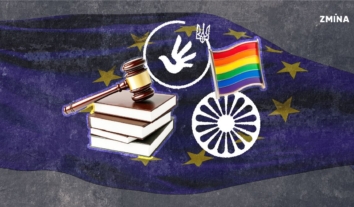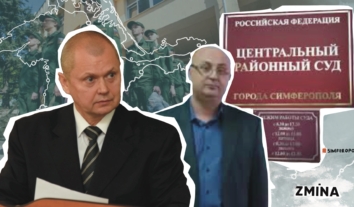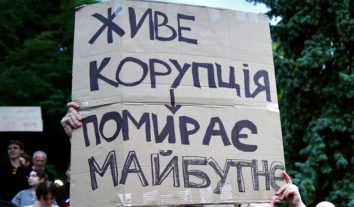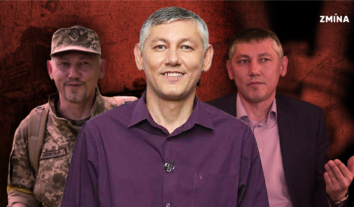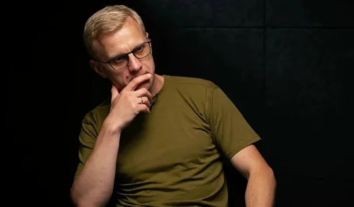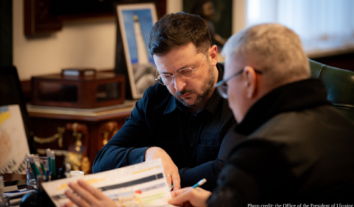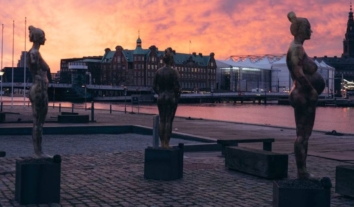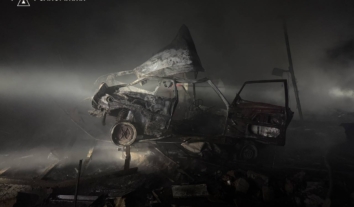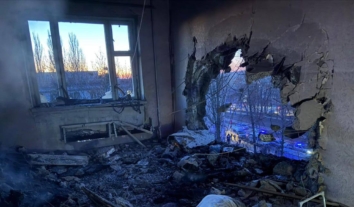Multiethnic Ukraine: 134 Indigenous Peoples and Ethnic Minorities
Traveling youth exhibition “Together” presents Ukraine as a multiethnic state with room for every people, believe the organizers, “Space of Tolerance” educational center in Kyiv.
The exhibition’s many stands, sponsored by the Council of Europe, display very personal and moving stories and photographs from young people of Ukraine’s different ethnic communities.
Yaroslava Shkolna, the 14-year-old high school student from Kyiv and tour guide for the exhibition, casually tells me that Ukraine is a unified country and that many of her friends have diverse ethnic origins. She believes that, as teenagers, they have the same concerns, regardless of ethnicity or faith.
“I don’t find it difficult to interact with any of my peers. They are just teenagers like me. Some have different traditions, religions, or look different, but we all are teenagers, and we all are people. We all have the same worries, like getting a poor grade at school,” smiles Yaroslava.
She says that she enjoys giving tours of the exhibition, as many visitors are able to see Ukraine through new eyes.
“No human being is illegal”
In addition to sections on the Armenian, Crimean Tatar, Jewish, Roma, Moldovan, and other communities, there are exhibits containing the stories of refugees and the internally displaced. Anna Lenchovska, Executive Director of the center and the exhibition’s organizer, shares that she originally could not imagine what kind of stories her displays would end up telling.
Lenchovska takes me to a stand with a photo of a young woman. Her name is Maria, and she is from Yalta, Crimea. A year ago, at the very beginning of Maidan, she and few others were demonstrating with Ukrainian flags.
“There were about fifteen of us who came. It felt so cool – Yalta with Euromaidan,” Anna recalls of her first conversation with Maria.
Later, however, Lenchovska would read a very different interview. Maria was discriminated against for her views by the university president and the faculty, who openly called her and a few other students “traitors”.
“They were told that the university might be closed because of them. They were first-year students, only 18 years old… Before that interview Maria never shared her pain with anyone. Sheevenstoppedthinkingaboutit. Was she embarrassed, scared?” wonders Lenchovska.
A story of Andrey from Luhansk is quite emotionally similar. During the celebration of 200th birthday of the Ukrainian national poet Taras Shevchenko on March 9, 2014, many people were singing and wearing vyshyvankas (Ukrainian traditional clothing). After a few minutes, they were surrounded by thousands of demonstrators from a pro-Russian march who then began beating them.
Andrey had to move to Kamyanets-Podilsky with his family. However, being forced migrants, they faced extraordinary difficulties when trying to find an apartment.
“Andrey is only a teenager. Every teenager has a right to some protection by the government, so that s/he isn’t being tossed around in life,” Ulyana Ustinova, one of the organizers, recalls an interview with Andrey. “Listening to him was hard, especially about how his peers treat migrants. Their seemingly innocuous ‘guy talk’ still affected him greatly… A few times he and his friends in Kyiv nearly got into a fight. Whenever someone was killed or wounded in the East Ukraine, they would tease him: ‘What did you do that for?’”
Ulyana is holding her eighteen month old daughter Nancy. The choice of the name wasn’t random. Ulyana explained that she and her husband didn’t want to force an identity on their child, and thus gave her a name that didn’t have any ethnic or national connotations. The young couple is convinced that it’s important for their daughter to choose an identity for herself.
Next to Maria and Andrey’s stories there is Pedram’s, an Iranian refugee. Then there is a short explanation of a difference between a refugee, a migrant, an asylum seeker, and an internally displaced person. This is followed by the words of the Nobel Peace Prize winner and Holocaust survivor Elie Wiesel: “You who are so-called illegal aliens must know that no human being is illegal. That is a contradiction in terms. Human beings can be beautiful or more beautiful, they can fat or skinny, they can be right or wrong, but illegal? How can a human being be illegal?”
“These words are the main point we are trying to convey with our exhibition: don’t judge a person by their ethnicity or status. Get to know them, ask them questions… Tonya here, for instance, an ethnic Russian, was forced to leave Crimea. She says that many have begun treating Russians very poorly. She wonders how you can judge a person based solely on where they come from,” says Lenchovska.
On Ukraine in Arabic
Mohammed Farajallah, a Palestinian-Ukrainian visiting the exhibition, says that events like this are extremely important for Ukraine’s unity, for moving forward instead of fixating on past tragedy.
“This exhibition reflects the mosaic of the Ukrainian people. Unfortunately, many things come to us with delay. The struggle of the Crimean Tatars started getting recognition only after the loss of Crimea. I saw Muslims in Donbass who joined the Ukrainian army and are now protecting the peace with Qurans at their side. The Ukrainian government doesn’t see them yet, though. Would it only notice them if, God forbid, Ukraine loses Donbass?”
Mohammed tells me that he was born in Palestine. He came to Ukraine to escape from war and to get an education. He met a Ukrainian woman, and got married. Now they are raising two children, a son Yasin and a daughter Amira.
“I realized that I love Ukraine as much as Palestine. It’s my second home. Our children speak Arabic and Ukrainian, and they are also studying English. It’s important for us that they know both cultures. Hopefully, they could become a bridge between Palestine and Ukraine. It would only make Ukraine better”. He adds, “Our children speak Ukrainian better, though. They are also clever when trying to get candy: if someone near them is Palestinian, they say they are Palestinian, if Ukrainian, then Ukrainian.”
Farajallah suggests that Ukraine needs to have a broader view of the world. “If Russian embargoes create problems with energy, what’s the big deal? There’s plenty in the Middle East”, he says.
After last winter’s events, Mohammed founded a news portal that covers the situation in Ukraine in Arabic. His audience consists of all twenty two Arab countries.
“I realized how important it is to cover the situation in Ukraine for the Arab world. Russia has won many battles there: first, with its billions, and second, with its monopoly on forming a view of Ukraine”, explains Farajallah.
He believes that covering events in Ukraine is his duty.
“Maidan aren’t alcoholics, and Ukrainians aren’t Russians. Ukrainians want a change and want to pave their own road, not be a ‘little brother.’ It’s actually the other way around – everything stems from Kyivan Rus. That’s what we are writing about. We also aim to bring the voice of the Arab world to Ukraine, so that it can be heard,” says Farajallah.
Destroying Deep-Rooted Stereotypes
Yulia Krylova, a third-year student at the National Pedagogical Dragomanov University, was fascinated by the sections on the Ukrainian Jewry. She was particularly taken aback by the fact that they were not allowed to settle in the capital or in the major cities.
“In the end of 18th century Jews weren’t allowed to live in the capital, which explains why there were so many living 200-300 kilometers away from here. One of the displays tells you that the towns of Monastyryshche and Sharhorod – in Cherkasy and Vinnitsya Oblast respectively – were once over 75% Jewish. In Uman, for instance, the Jewish religious leader Tzaddik Nachman is buried. I always thought that this man was from Israel, and here I found out that he was a Ukrainian born in the town of Medzhybizh of Khmelnytskyi Oblast,” Yulia shares in her excitement.
She adds that current Ukrainian law guarantees linguistic and cultural development for ethnic groups. It is therefore worthwhile not only to be simply hospitable, but also to learn about the culture of our neighbors and destroy deep-rooted stereotypes.
“Who are the Ukrainians then? They are much more than just ethnic Ukrainians. For example, there is a Moldavanka district of Odessa. Most of the buildings there were built by Moldovans, who are a large ethnic group in Odessa. Taras Shevchenko University was created by its German faculty. The city of Chernivtsi was built by Jews, Austrians, and Romanians. Chersonesus is an ancient Greek colony in what is now Ukraine. All of these are parts of our rich national history. To single out only ethnic Ukrainians is like making borscht using nothing but beets,” comments Lenchovska.
As a matter of fact, there are 134 ethnic minorities and indigenous peoples in Ukraine, and Article 11 of the Ukrainian Constitution guarantees all of them “development of ethnic, cultural, linguistic, and religious identity.”

